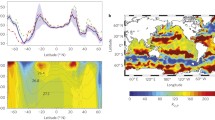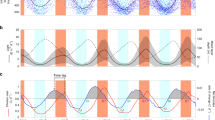Abstract
We investigate the influence of mixotrophy on the dynamical properties of a six-population model of a three–trophic level Southern Ocean ecosystem. We find that including mixotrophic interactions between the lowest trophic level populations can significantly influence the dynamics of the highest trophic level populations, and in extreme cases lead to extinctions. Significantly, not only is the strength of the mixotrophic interaction important, it matters how it is included in the model, as a specialist or generalist grazer. We note in particular that the generalist formulation is inappropriate for “green” mixotrophs that fuel the majority of their growth by photosynthesis. The model can have complicated dynamics when subject to large amplitude, regular forcing, suggesting the sea ice—salps link may be obfuscated by endogenous population oscillations. Further, we observe that constructing the model within the Conservative Normal framework allows insights into the bifurcation behaviour of the model.













Similar content being viewed by others
References
Atkinson, A., Siegel, V., Pakhomov, E., Rothery, P. (2004). Long-term decline in krill stock and increase in salps within the Southern Ocean. Nature, 432, 100–103.
Bates, M.L., Bengtson Nash, S.M., Hawker, D.W., Norbury, J., Stark, J.S., Cropp, R.A. (2015). Construction of a trophically complex near-shore Antarctic food web model using the Conservative-Normal framework with structural coexistence. Journal of Marine Systems, 145, 1–14.
Boyd, I.L. (2002). Estimating food consumption of marine predators: Antarctic fur seals and macaroni penguins. Journal of Applied Ecology, 39, 103–119.
Clarke, A., & Tyler, P.A. (2008). Adult antarctic krill feeding at abyssal depths. Current Biology, 18, 282–285.
Cropp, R.A., Bengtson Nash, S.M., Hawker, D. (2014). A model to resolve the dynamics of organochlorine pharmacokinetics in migrating humpback whales. Environmental Toxicology and Chemistry, 33(7), 1638–1649.
Cropp, R.A., & Norbury, J. (2015). Population interactions in ecology a Rule-Based approach to modeling ecosystems in a Mass-Conserving framework. SIAM Review, 57(3), 437–465.
Cropp, R.A., Moroz, I.M., destabilisation, J. Norbury. (2017). Sequential boundary eigenvalue (seBEDes): An expert method for parameter screening and estimation in complex ecosystem models. Environmental Modelling and Software, 90, 167–181.
Cropp, R.A., Moroz, I.M., Norbury, J. (2017). The role of grazer predation strategies in the dynamics of consumer-resource based ecological models. Journal of Sea Research, 125, 34–46.
Cropp, R.A., & Norbury, J. (2009). Simple predator-prey interactions control dynamics in a plankton food web model. Ecological Modelling, 20, 1552–1565.
Cropp, R.A., & Norbury, J. (2012). The mechanisms of coexistence and competitive exclusion in complex plankton ecosystem models. Ecosystems, 15, 200–212.
Cropp, R.A., & Norbury, J. (2015). Mixotrophy: the missing link in consumer-resource-based ecologies. Theoretical Ecology, 8, 245–260.
Crane, K.W., & Grover, J.P. (2010). Coexistence of mixotrophs, autotrophs, and heterotrophs in planktonic microbial communities. Journal of Theoretical Biology, 262(3), 517–527.
Droop, M.R. (1968). Vitamin B12 and marine ecology. IV. The kinetics of uptake, growth and inhibition in Monochrysis lutheri. Journal of the Marine Biological Association UK, 48, 689–733.
Franks, P. (2002). NPZ Models of Plankton Dynamics: Their construction, coupling to physics, and application. Journal of Oceanography, 58, 379–387.
Franks, P. (2002). Planktonic ecosystem models: perplexing parameterizations and a failure to fail. Journal of Plankton Research, 31, 1299–1306.
Flynn, K.J. (2003). Modelling multi-nutrient interactions in phytoplankton, balancing simplicity and realism. Progress in Oceanography, 56, 249–279.
Flynn, K.J., & Mitra, A. (2009). Building the “perfect beast”: modelling mixotrophic plankton. Journal of Plankton Research, 31(9), 965–992.
Flynn, K.J., Stoecker, D.K., Mitra, A., Raven, J.A., Glibert, P.M., Hansen, P.J., Graneli, E., Burkholder, J.M. (2013). Misuse of the phytoplankton - zooplankton dichotomy: the need to assign organisms as mixotrophs within plankton functional types. Journal of Plankton Research, 35, 3–11.
Gentleman, W., Leising, A., Frost, B., Strom, S., Murray, J.D. (2003). Functional responses for zooplankton feeding on multiple resources: a review of assumptions and biological dynamics. Deep Sea Research Part II: Topical Studies in Oceanography, 50, 2847–2875.
Grant, S.M., Hill, S.L., Trathan, P.N., Murphy, E.J. (2013). Ecosystem services of the Southern Ocean: trade-offs in decision-making. Antarctic Science, 25(5), 603–617.
Hadjiavgousti, D., & Ichtiaroglou, S. (2006). Allee Effect in Population Dynamics Existence of Breather-like Behavior and Control of Chaos through Dispersal. I. J. Bifurcation and Chaos, 16, 2001–2012.
Hill, S.L., Murphy, E.J., Reid, K., Trathan, P.N., Constable, A. (2006). Modelling Southern Ocean ecosystems: krill, the food web, and the impacts of harvesting. Biological Reviews, 81, 581–608.
Holling, C.S. (1959). Some characteristics of simple types of predation and parasitism. Canadian Entomologist, 91, 385–398.
Ichii, T., & Kato, H. (1991). Food and daily food consumption of southern minke whales in the Antarctic. Polar Biology, 11, 479–487.
Ivlev, V.S. (1961). Experimental Ecology of the Feeding of Fishes. New Haven: Yale University Press.
Jost, C., Lawrence, C.A., Campolongo, F., van de Bund, W., Hill, S., DeAngelis, D.L. (2004). The effects of mixotrophy on the stability and dynamics of a simple planktonic food web model. Theoretical Population Biology, 66, 37–51.
Koen-Alonso, M. (2007). A process-oriented approach to the multi-species functional response. In Rooney, N (Ed.) From Energetics to Ecosystems: The Dynamics and Structure of Ecological Systems, (Vol. 1 pp. 1–36). Netherlands: Springer.
Kot, M. (2001). Elements of Mathematical Ecology. Cambridge: Cambridge University Press.
Lockyer, C. (1981). Growth and energy budgets of large baleen whales from the Southern Hemisphere. Mammals in the Seas, 3, 379–487. FAO, Rome.
Loeb, V., Siegel, V., Holm-Hansen, O., Hewitt, R., Fraserk, W., Trivelpiece, W., Trivelpiece, S. (1997). Effects of sea-ice extent and krill or salp dominance on the Antarctic food web. Nature, 387, 897–900.
Lotka, A.J. (1925). Elements of Physical Biology. Baltimore: Wilkins and Kilkins.
May, R.M., Beddington, J.R., Clark, C.W., Holt, S.J., Laws, R.M. (1979). Management of multispecies fisheries. Science, 205, 267–277.
May, R.M. (1981). Theoretical Ecology Principles and Applications. Princeton, Oxford: Blackwell Science Inc.
Michaelis, L., & Menten, M.L. (1913). Die Kinetik der Invertinwirkung. Biochemische Zeitschrift, 49, 333–369.
Mitra, A., Castellani, C., Gentleman, W., Jonasdottir, S.H., Flynn, K., Bode, A., Halsband, C., Kuhn, P., Licandro, P., Agersted, M.D., Calbet, A., Lindeque, P.K., Koppelmann, R., Moller, E.F., Gislason, A., Nielsen, T.G., John, M. S. t. (2014). Bridging the gap between marine biogeochemical and fisheries sciences; configuring the zooplankton link. Progress in Oceanography, 129, 176–199.
Mitra, A., Flynn, K.J., Burkholder, J.M., Berge, T., Calbet, A., Raven, J.A., Graneli, E., Glibert, P.M., Hansen, P.J., Stoecker, D.K., Thingstad, F., Tillmann, U., Vage, S., Wilken, S., Zubkov, M.V. (2014). The role of mixotrophic protists in the biological carbon pump. Biogeosciences, 11, 995–1005.
Mitra, A., Flynn, K.J., Tillmann, U., Raven, J.A., Caron, D., Stoecker, D.K., Not, F., Hansen, P.J., Hallegraeff, G., Sanders, R., Wilken, S., McManus, G., Johnson, M., Pitta, P., Vage, S., Berge, T., Calbet, A., Thingstad, F., Jeong, H.J., Burkholder, J.A., Glibert, P.M., Graneli, E., Lundgren, V. (2016). Defining planktonic protist functional groups on mechanisms for energy and nutrient acquisition: Incorporation of diverse mixotrophic strategies. Protist, 167(2), 106–120.
Moeller, H.V., Peltomaa, E., Johnson, M.D., Neubert, M.G. (2016). Acquired phototrophy stabilises coexistence and shapes intrinsic dynamics of an intraguild predator and its prey. Ecology Letters, 19(4), 393–402.
Moroz, I.M., Cropp, R.A., Norbury, J. (2016). Chaos in plankton models Foraging strategy and seasonal forcing. Ecological Modelling, 332, 103–111.
Morozov, A., & Petrovskii, S. (2013). Feeding on multiple sources towards a universal parameterization of the functional response of a generalist predator allowing for switching. PLOS One, 8(9), e74586: 1–8.
Murphy, E.J., Cavanagh, R.D., Hofmann, E.E., Hill, S.L., Constable, A., Costa, D.P., Pinkerton, M.H., Johnston, N.M., Trathan, P.N., Klinck, J.M., Wolf-Gladrow, D.A., Daly, K.L., Maury, O., Doney, S.C. (2012). Developing integrated models of Southern Ocean food webs Including ecological complexity, accounting for uncertainty and the importance of scale. Progress in Oceanography, 102, 74–92.
Pastor, J. (2008). Mathematical Ecology of Populations and Ecosystems. Chichester: Wiley-Blackwell.
Porter, K. (1973). Selective grazing and differential digestion of algae by zooplankton. Nature, 244, 179–180.
Sailley, S., Vogt, M., Doney, S.C., Aita, M.N., Bopp, L., Buitenhuis, E.T., Hashioka, T., Lima, I., Le Quere, C., Yamanaka, Y. (2013). Comparing food web structures and dynamics across a suite of global marine ecosystem models. Ecological Modelling, 261-262, 43–57.
Scheidat, M., Bornemann, H., Burkhardt, E., Flores, H., Friedlaender, A., Kock, K.H., Lehnert, L., van Franeker, J., Williams, R. (2008). Antarctic sea ice habitat and minke whales. In: Annual Science Conference in Halifax, 22-26 September September, Halifax, Canada.
Smith, E.L. (1936). Photosynthesis in relation to light and carbon dioxide. Proceedings of the National Academy of Sciences of the United States of America, 22, 504–511.
Smout, S., Asseburg, C., Matthiopoulos, J., Fernandez, C., Redpath, S., Thirgood, S., Harwood, J. (2010). The functional response of a generalist predator. PLoS ONE, 5(5), 1–7.
Steinberg, D.K., Ruck, K.E., Gleiber, M.R., Garzio, L.M., Cope, J.S., Bernard, K.S., Stammerjohn, S.E., Schofield, O.M.E., Quetin, L.B., Ross, R.M. (2015). Long-term (1993-2013) changes in macrozooplankton off the Western Antarctic Peninsula. Deep-SeaResearch I, 101, 54–70.
Stitch, H.-B., & Lampert, W. (1984). Growth and reproduction of migrating and non-migrating Daphnia species under simulated food and temperature conditions of diurnal vertical migration. Oecologia, 61, 192–196.
Vitousek, P.M., & Matson, P.A. (2012). Nutrient cycling and biogeochemistry. In Levin, S. (Ed.) The Princeton Guide to Ecology (pp. 330–339). New Jersey: Princeton University Press.
Volterra, V. (1926). Variations and fluctuations of the numbers of individuals in animal species living together. In: Reprinted in 1931 in Chapman, R.N. Animal Ecology. McGraw Hill, New York.
Wang, S., Maltrud, M., Elliott, S., Cameron-Smith, P., Jonko, A. (2018). Influence of dimethyl sulfide on the carbon cycle and biological production. Biogeochemistry, 138, 49–68.
Ward, B.A., Dutkiewicz, S., Barton, A.D., Follows, M.J. (2011). Biophysical aspects of resource acquisition and competition in algal mixotrophs. The American Naturalist, 178(1), 98–112.
Wilken, S., Huisman, J., Naus-Wiezer, S., Van Donk, E. (2013). Mixotrophic organisms become more heterotrophic with rising temperature. Ecology Letters, 16, 225–233.
Acknowledgements
The authors thank the editors and two anonymous reviewers for their thoughtful and constructive contributions. JN, IMM, and RC wish to thank Dr Keith Gillow for the cheerful and consummately competent provision of computing support at the Mathematical Institute, University of Oxford over a number of years. RC wishes to also thank the Mathematical Institute, University of Oxford; Lincoln College, Oxford; and St Hilda’s College, Oxford for support in January 2018.
Author information
Authors and Affiliations
Corresponding author
Additional information
Publisher’s Note
Springer Nature remains neutral with regard to jurisdictional claims in published maps and institutional affiliations.
Rights and permissions
About this article
Cite this article
Norbury, J., Moroz, I.M. & Cropp, R. The Role of Mixotrophy in Southern Ocean Ecosystems. Environ Model Assess 24, 421–435 (2019). https://doi.org/10.1007/s10666-019-09670-0
Received:
Accepted:
Published:
Issue Date:
DOI: https://doi.org/10.1007/s10666-019-09670-0




